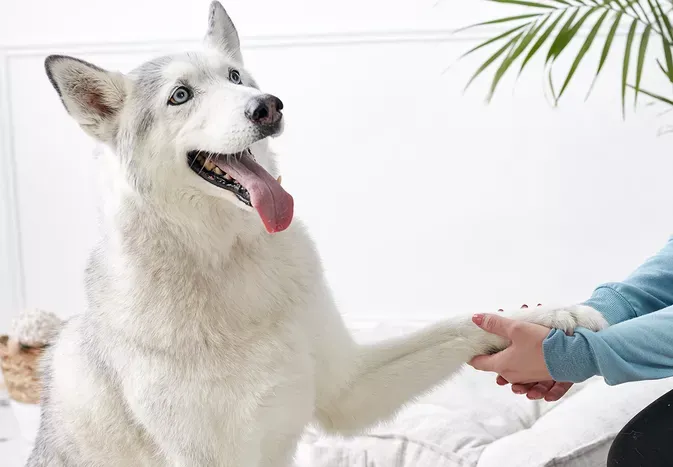How to Train Your Dog to Shake Paws
Updated on 04/26/24

Master the Delightful Art of Paw-Shaking: A Comprehensive Guide to Training Your Canine Companion
In the realm of canine companionship, there are few gestures as endearing and symbolic as the humble handshake. Whether it's a playful greeting or a sign of respect, teaching your dog to shake paws not only strengthens your bond but also opens up a world of delightful possibilities. Join us on this extraordinary journey as we delve into the secrets of paw-shaking mastery.
1. Laying the Foundation: Building a Solid Relationship
Before embarking on the training adventure, it's crucial to establish a foundation of trust and understanding with your canine companion.
- Positive Reinforcement: Shower your furry friend with treats, praise, and affection whenever they exhibit desirable behaviors. This positive reinforcement technique will help them connect the act of paw-shaking with rewards, making them eager to repeat it.
- Consistency is Key: Establish clear and consistent training cues and routines to avoid confusion. Use the same command ("shake" or "paw") and hand gesture every time you want your dog to shake paws.
- Short and Sweet: Keep training sessions short and engaging, especially in the initial stages. A few minutes of dedicated practice each day will yield better results than marathon sessions that can lead to boredom and frustration.
2. The Luring Technique: A Paw-some Initiation
Now, let's dive into the practical aspects of training. The luring technique is an effective way to introduce the concept of paw-shaking:
- The Tasty Treat: Hold a high-value treat close to your dog's nose and gradually move it towards their paw.
- Follow the Nose: As your dog follows the treat, their paw will naturally extend towards it. Capture this moment by saying the command "shake" or "paw."
- Reward the Effort: Once their paw touches your hand, immediately reward them with the treat and plenty of praise.
3. Gradual Progression: Step-by-Step Refinement
Once your dog understands the basic concept, it's time to gradually refine the behavior:
- Reducing the Lure: Gradually move the treat further away from their paw, encouraging them to extend their paw without relying on the lure.
- Changing Positions: Practice the paw-shake in different positions, such as sitting, standing, and even lying down. This adaptability will enhance their understanding and make the skill more versatile.
- Adding Duration: Increase the duration for which your dog holds their paw in your hand. Start with a few seconds and gradually work your way up to several seconds or even minutes.
4. Troubleshooting Common Challenges: Paw-sitive Solutions
Along the training journey, you may encounter a few common challenges:
- Resistance: If your dog resists giving their paw, try different treats or activities to find what motivates them the most.
- Inconsistent Response: Ensure you're using the same command and hand gesture consistently. Patience and repetition will help your dog understand what you're asking.
- Pulling Too Hard: Gently hold your dog's paw and guide it into a gentle shake. Avoid pulling on their paw, as this can cause discomfort or injury.
5. Unleashing the Paw-some Potential: Fun and Practical Applications
Mastering the paw-shake is not just a cute trick; it has numerous practical applications:
- Greeting Guests: Teach your dog to greet visitors with a polite paw-shake, creating a welcoming and friendly atmosphere.
- Physical Therapy: Paw-shaking can be incorporated into physical therapy exercises for dogs recovering from injuries or surgeries.
- Bonding Activity: Training your dog to shake paws is an enjoyable and rewarding bonding experience that strengthens your connection and creates lasting memories.
Paw-some Examples: Success Stories in the Making
Here are a few heartwarming examples to inspire your training journey:
- Lola the Golden Retriever: Lola has become the star of her neighborhood, charming everyone with her enthusiastic paw-shakes and infectious smile.
- Max the Border Collie: Max, an agility champion, incorporates paw-shakes into his performance, adding a touch of style and audience engagement.
- Bella the Therapy Dog: Bella uses her paw-shaking skills to comfort and uplift patients in hospitals and nursing homes, bringing joy and a sense of connection to those in need.
Paw-fect Conclusion: A Bond Beyond Worte
Teaching your dog to shake paws is a testament to the extraordinary bond you share. It's a skill that brings endless joy, strengthens your communication, and creates countless opportunities for connection and fulfillment. Embrace this journey with patience, love, and an abundance of treats, and you'll be amazed at the paw-some results you achieve together.
Explore More Pets

Basic Training
Puppy and Baby Introductions

Working Dog Breeds
All About Search and Rescue Dogs

Dog Treatments
Puppy Vaginitis: Signs, Causes and Treatment

Dog Adoption
After More Than 1,200 Days in the Shelter, Coco Goes Home

Basic Training
How to Train Your Puppy to Go on Potty Pads

Hybrid Dog Breeds
The Difference Between a Mutt, Mixed Breed, or Designer Dog?

Dog Treatments
Nail Problems in Dogs

Puppies
7 Reasons Why Two Dogs Are Better Than One